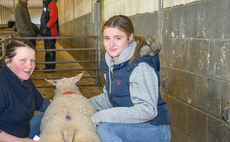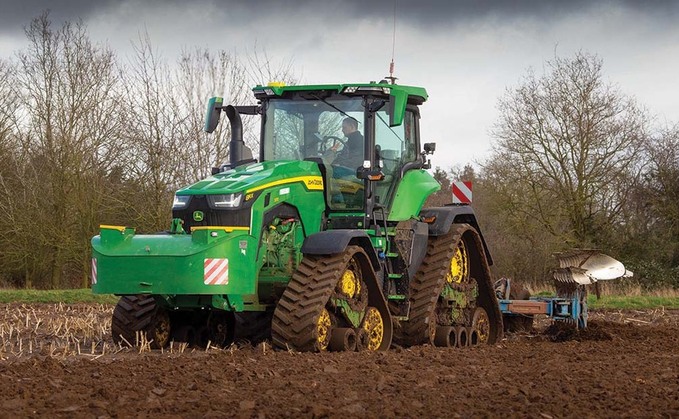
A change in machinery policy has led Stafford Proctor and Sid Mann, of Long Sutton-based Proctor Bros, to buy two John Deere track layer tractors. Alex Heath finds out more
Farming on the borders of Lincolnshire, Norfolk and Cambridgeshire, Proctor Bros' ground comprises a variety of soil types, all with a large proportion of silt, which requires careful management, says owner Stafford Proctor and operations manager Sid Mann.
Mr Proctor says: "The silty soils we farm on are good for a wide range of cropping, but they do not have the same tractive strength that sands and clays have. Coupled with tighter weather
windows, the way we work on them has had to change.
"We previously ran four Caterpillar and Challenger twin-track machines but, with a greater workload in shorter periods, they had run their course and were not capable of what we wanted.
"In addition, twin tracks have a tendency to slip and smear when the surface is greasy, meaning we were limited on what we could do with our power."
In 2012, the farm evaluated its front-line power and decided the time had come to explore other high horsepower options, with one of the Challengers leaving the farm, making way for a Fendt 936.
Mr Mann says: "The Fendt tractors we've had have been good machines, but they were not able to put the power down properly and did not tread lightly enough, leading us back to track layers and in the John Deere direction with an 8360RT in 2015.
"We decided to invest in newer track layers with more power which could pull larger implements faster, covering more ground each day. In 2017 we bought the Case IH Quadtrac 620 and the following year saw the Rowtrac 380 CVX working. We were impressed with its ability, so in 2018 we bought a Rowtrac, with the rest of the twin-tracks leaving the farm."
The farm was impressed with the capability of the Case IH Rowtrac. "It was a remarkable tractor and did everything we asked of it," says Mr Mann.
"However, reliability issues on both the Rowtrac and Quadtrac meant during critical times in autumn and spring, we were without the tractors we relied on to get crops in the ground. And since we had gone from four tractors that were all roughly capable of doing the same jobs to two, we have limited room for downtime.
"Running a scratch fleet of high horsepower tractors means fewer staff are needed to cover the same ground, but leaves us in a predicament when breakdowns occur.
"The Case tractors proved the concept could work, with the half track and articulated tractors capable of pulling any of our implements. Admittedly the half track will not pull the bigger kit at the same speed if the artic is down, but it will get the job done," he adds.
"Then John Deere launched the 8RX and we were immediately interested as it was the solution we had been looking for. We had the 8RX 370 on demo last year and bought that to run alongside the 9620RX, which was already on the farm having replaced the Quadtrac in June."
The farm has gone from a mixed fleet to one that is predominantly Deere-based, with experience of the brand and local dealers Doubleday Group stretching back to the 50 Series and few reliability issues in that time, says Mr Proctor.
In addition to the owned tractors, the farm hires an 8R for autumn work and a 7R in spring.
Mr Proctor says: "It affords us more flexibility for the size and type of tractor we need at certain times of the year, without it sitting in our yard when it is not needed."
Gary Sleightholme is the operator of the new 8RX and the farm's previous Rowtrac.
He says the new machine is a big improvement in terms of usability over the outgoing tractor, with the manufacturer's new control layout and joystick, but whether it is a better performer is yet to be decided. However, one feature of the 8RX that is different to the Rowtrac is how lightly it treads.
Mr Sleightholme says: "On the Rowtrac, the 650mm-wide front tyres would make a noticeable indent in the soil and the tracks then sat in the impression and made it wider.
With the 8RX, the tracks on the front are roughly the same width, but have a longer contact patch to spread the weight and the 760mm-wide rear tracks make only a minimal impression. Also, when crossing ruts, the tracks ride over the top, rather than dropping in like a wheel does.
"On the road, you would not know it has tracks, with the cab and seat suspension working exceptionally well together, it is very comfortable to operate.
"And that extends to the CommandPro joystick. Having operated Fendts in the past, it is similar in its operation, but more user-friendly with plenty of configuration options. I can save the buttons I want to use with each implement and at start-up the screen explains what each button is assigned to.
"Visibility is also impressive. I can see the rear idler roller out of the back window and manoeuvrability is good, turning tighter than a wheeled 8R without the berm of a twin track," reports Mr Sleightholme.
However, Mr Mann who is the main operator of the 9RX, says the Case IH machine had the edge in the articulated department, with a more refined cab and better pulling power, but the integration between the JD artic and the 8RX is better for sending data.
The farm opted for the second largest tractor in the 8RX range as the top model does not have a step-less gearbox.
Mr Proctor says: "We need the AutoPowr transmission for potato work as the E23 powershift transmission will not go slow enough. Come planting time, the 8RX is responsible for all the bed tilling and forming, establishing the rows with Greenstar RTK guidance.
"In addition, it is used with a six- or eight-metre Vaderstad Rapid, six-metre combi-drill, nine-furrow plough and nine-leg subsoiler throughout the year.
"All the implements the 9RX would pull are well managed by the 8RX too, at a slower pace, but we are still covering ground.
"We managed to get 243ha drilled in two long days with the two Vaddys and the Deeres in autumn. Work rates when the weather changes drop to about 20ha a day when the plough and combi-drill come out."
So far the farm is impressed with the performance of the 8RX, however the team reports there are a few areas for improvement.
It would be better with a sixth spool as the hydraulic top link has to be left at base with certain implements. Also, they report the mud guards are not sufficient, with the tractor well adept at covering itself in mud.
And from Gary's point of view, the speed selector and GPS engage buttons are too close together and easily pressed in error, with the tractor taking off at high speed on more than one occasion while positioning for another pass up the field.
However, the team agrees these shortcomings are easily lived with.
Mr Proctor says the tracks should be good for 4,000 hours, with little sand or stone content in their soils to wear the tracks or mid-rollers.
Overall, they are happy with the purchase of the 8RX. Mr Mann says: "It has so far performed as we had hoped it would and we think it will prove to be a capable tractor to work alongside the articulated machine. We just hope the reliability is there so we can continue running a streamlined fleet."
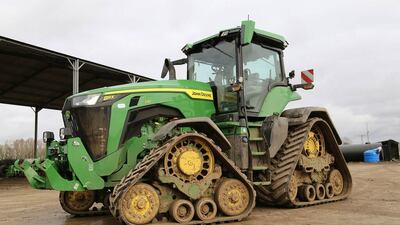
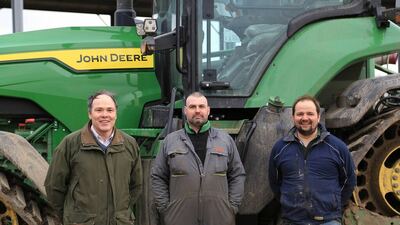
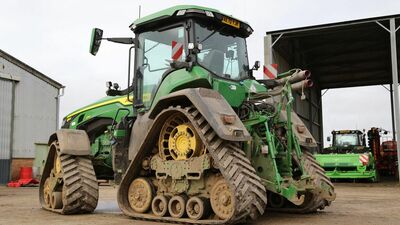


Verdict
The farm says so far, the 8RX 370 is living up to its expectations, but whether it is a better pulling tractor than its predecessor is still up for debate. One thing that is given though is its improved comfort in the cab, with operator Gary Sleightholme saying: "On the road, you would not know it has tracks, with the cab and seat suspension working exceptionally well together, it is very comfortable to operate. And that extends to the CommandPro joystick too."
With regards to its foot print, the farm says it leaves less of an imprint then a half-track machine, rides over ruts better and does not leave a berm like a twin-track machine.
More than anything however, the farm now has a back up tractor to its main cultivating machine, that can step in if the larger articulated machine breaks down.
























